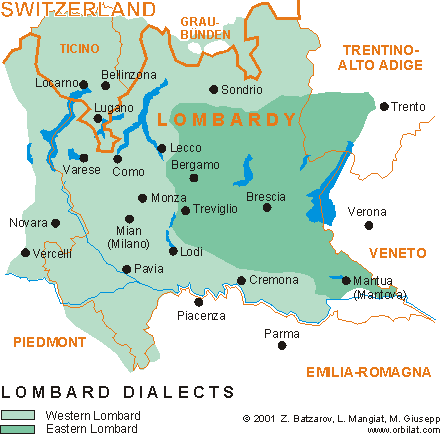Table of Contents
Lombard in Italy
Language designations:
- In the language itself: lumbaart, or lengua lumbarda
- ISO 639-3 standard: language's ISO 639-3-LMO
Language vitality according to:
Click here for a full overview of the language vitality colour codes.
Linguistic aspects:
- Classification: Indo-European → Gallo-Italian. For more information, see language resource at Glottolog
- Script: Latin/Roman script
Listen to the language here (Milanese variety).
Language standardization
The Unesco Atlas of the World's Languages in Danger states that Lombard is a cluster of essentially homogeneous varieties, however, an accepted standard does not exist. It is disqualified from accessing higher domains and is exclusively used on an informal level.
Traditional orthography is based on French and therefore gives the reader a blurred first impression of Lombard phonology. Recently, a more phonetic orthography has evolved in Ticino and Valtellina - the Lombard regions along the common borders of Switerland and Italy - which is strongly influenced by German ortography, identifiable through the usage of umlaut marks ö and ü.
Concerning the mutual intelligibility with Italian, a case study found a 44,3% intelligibility rate of Lombard with standard Italian which is relatively low1).
The main institiution to research the Lombard variety is the CDE or Centro di dialettologia e di etnografia located in Bellinzona, Switzerland. In 2004, the CDE released a dictionary containing five volumes which cover all the Lombard varieties spoken in the Swiss areas. Lombard is furthermore used in television and radio broadcast in the area around Bellinzona. Italy does not have a comparable institution, which is why there is significantly less data on Lombard as spoken in Italy2).
Projects such as In_Lombard promote the collection of data on Lombard and its standardization by creating a linguistic observatory online.
Demographics
Language Area
The online encylopedia Orbis Latinus states that Lombard is spoken in the Italian region of Lombardy, the Novara province in Piedmont and in Switzerland (Canton Ticino and parts of Graubünden/Grigioni).
The preceding map shows the two main Lombard dialect clusters, Eastern and Western Lombard.
Western Lombard includes: Milanese, Lodigian, Comask, Ticinese, Varesotto, Novarese, Pavese, Vogherese, Lomellinese, Bosin (Ligurian-Lombard), Cremonese, Valtellinese and other minor varieties.
Eastern Lombard includes: Bergamask, Brescian, Cremask, Mantuan, Tirolian (Tyrolean) Lombard and other minor varieties.
Speaker numbers
The Unesco Atlas of the World's Languages in Danger states a number of 3,500,000 speakers based on various sources.
In Italy most of Lombard speakers are from the older generations. Younger generations use Italian due to media influences and school3).
Education of the language
History of language education:
There is no evidence of the usage of Lombard in formal education in neither Switzerland nor Italy.
Legislation of language education
European
Even though Italy signed the European Charter for Regional or Minority Languages (ECRML) in 2000, it has not ratified it.
National
Italy defines minority langauges legally by a national law, N. 482/99, which protects twelve languages: Catalan, Occitan, Albanian, German, Greek, Slovene, Croatian, French, Francoprovençal, Friulian, Ladin and Sardinian 4). The Italian government considers Lombard a dialect of Standard Italian despite evidence of very limited mutual intelligibilty5).
Regional
In October 2016, Lombard received regional recognition within the region of Lombardia with Legge Regionale, oct 2016, n5., the Politiche regionali in materia culturale - Riordino normativo. There, broad measurements are taken for the promotion and safeguarding of the Lombard language, such as:
Article 1
- a) dissemination of knowledge and expansion of the use of the tangible and intangible cultural heritage present in the Lombardy region;
- d) promotion of respect for intellectual property rights related to the use of goods, cultural activities and entertainment;
- e) dissemination and safeguarding of cultures, traditions and popular music, typical food culture and linguistic heritage and enhancement of the multiform expressions of identities, languages and cultural productions in Lombardy;
- i) integration with policies and interventions related to the protection and enhancement of the environment and landscape, the promotion of the territory, tourism, crafts, research, education and training, welfare
Support structure for education on the language
According to a case study on Western Lombard, language planning - including the use of Western Lombard in education - is carried out by a number of uncoordinated initiatives by private bodies and institutions, which are centred around the Milanese variety6). The most prominent one is the Circolo Filologico Milanese, which offers courses of 25 lessons on the grammar, luterature, translations, converstaions, proverbs and visits to artistic cultural places 7). .
Education in practice
Bilingual education in Lombard and Italian has only been present in full-time education in a few experimental trials, with the focus on the Milanese variety. In higher education, Lombard is virtually absent8).
Learning resources and educational institutions
- FAR LOMBARD associazion per la lengua lombarda, an organisation for the Lombard Language with 15 lessons (with video) on the language, and an online accessable collection of Lombard books, music and videos.
- Learn to Speak Lombard makes an effort to bring together students of Lombard with native Lombard speakers. This exchange is not only limited to the linguistic aspects of Lombard but furthermore recognizes its distinct culture.
- Online dictionary Italian-Lombard
- short lesson on common phrases




